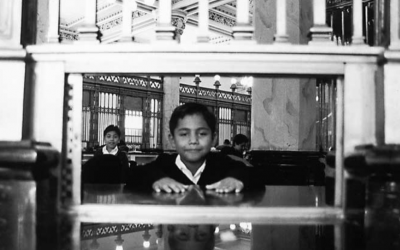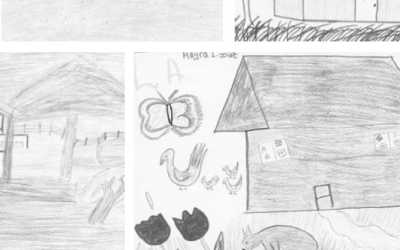Journey of Remembrance
Children’s Art Inspires Renewal

Left: Bianca/Honduras; right: Danitza Vásquez/Bolivia. Drawings from students at Herndon Middle School, Virginia
The Spanish-speaking immigrant children in northern Virginia busily draw what home looked like. Their vivid drawings give us a sense of the environment with which they feel comfortable, a physical space informed by nature.
A group of seventh and eighth grade English to Students of Other Languages (ESOL) students from Central and South America who attend Herndon Middle School in northern Virginia’s Fairfax County recently participated in a “Journey of Remembrance” to help explore how psychological research can inform interior design. The goal was to help create a more aesthetically inviting and efficiently designed interior of a social service center in Washington D.C.
The children’s pictures enrich the design project and are a vital aspect of it, precisely because of their expressive nature and unrestricted use of the elements of design in evoking the reality of their homeland. With their drawings, the children vividly showed us that immigrants do not disconnect from their native environment. Although physically separated from a particular landscape, its reality co-exists as if it were with their new environment. It even intrudes and imposes itself in myriad ways upon the workings of their lives. Young immigrants do not readily forget their native land.
In their “Journey of Remembrance,” the children drew a memory of “home” in their native land. The children produced pictures, which, although particular to their place of memory, convey a world where nature and the works of man do not merely co-exist: they intertwine. The children created pictures in which houses grow from the landscape and are one with the mountains, roofs are extensions of the trees, and the space for animals accommodates living space for a family. The glorious colors of the environment are the palette for the student artist; the territory is delineated by horizons, whether they are gardens, paths, fences, trees, or flowers—living organisms make room for man-made edifices. The exterior leads the viewer to the interior, to the hearth of the house.
The drawings also invite the viewer to imagine a world, a vision, that while not physically present to them, is actually alive and dominant in the immigrant’s journey of discovery in this new world. These images help students to cope with the loss of their native surroundings and give them hope to embrace the future “place” in their lives. They validate the “homes” of their parents, grandparents, and relatives. They create pictures to be guarded and cherished, not disregarded nor considered as outdated, insignificant, or obsolete. Although the students live in a cement city, the recollection of their native environment is not diminished. On the contrary, it is magnified so that the smallest detail evokes great emotion. Consequently, the need to be connected to that recollection is vital.
By illustrating these memories, the students’ images reach beyond the individual to the community in an attempt to help other immigrants on their journeys. The drawings formed the basis of a methodology employed in a Graduate Interior Design Thesis Project for the community center design. Mainly Hispanic immigrants will use the center. Originally, the drawings were intended to complement the methodology of interviewing adult immigrants who use the center’s services. The goal was to look for information in both the adult verbal interviews and children’s drawings that would yield cultural elements and symbols applicable to the interior design. What became apparent was the overwhelming influence of nature captured by the children in their artwork. The adult interviews also revealed that nature is an innate element in their lives and one that they miss in their present situation. However, the language deficiency of the adults could often not convey what the drawings of the children so vividly expressed. The children had no inhibitions or expectations with their drawings; their recollections are open, free from restraint or the threat of adult censure. The adults seemed constrained by formalities—real or imaginary—and even blighted memories.
The focus on nature in the children’s perceptions thus necessitates its inclusion in the design process. Nature serves as both a catalyst in the development of the design concept and a metaphor to help reach tangible design solutions. The applications of natural and “environmentally friendly” materials are part of a broader intention to explore the restorative aspect of nature on users within the interior environment. In applying materials that are less harmful to the environment, people will suffer less toxicity. By incorporating nature-inspired design elements, stress is reduced, physically and psychologically. This social service center is a place of renewal, where immigrants restore the loss incurred by unemployment, receive medical and dental assistance, seek guidance on immigration status, and benefit from educational programs.
The workers at the center are the true guides to restoration, but they can benefit from an environment that assists them on this journey. Nature fills the landscape of memory and past journey; now it should mediate the voyage in this new world where immigrants hold the riches of their past and renew the dreams for their future.
Winter 2004, Volume III, Number 2
Barbara M. Edwards is a 7th and 8th grade ESOL Teacher at Herndon Middle School, Fairfax County Public Schools in northern Virginia. Moira P. Gannon is a graduate student in the Department of Interior Design, Marymount University, Arlington, Virginia
Related Articles
Editor’s Letter: The Children
A blue whale spurts water joyfully into an Andean sky on my office door. A rainbow glitters among a feast of animals and palm trees. Geometrical lightning tosses tiny houses into the air with the force of a tropical hurricane.
Centroamerica
Cuando Pedro Pirir, fue despedido del taller mecánico donde trabajaba desde hacía muchos años, experimentó una sensación de injusticia y pena que luego se transformó en una voluntad…
Irregular Armed Forces and their Role in Politics and State Formation
As I sat in heavy traffic in the back of a police car during rush hour in the grimy northern zone of Rio de Janeiro, I studied the faces of drivers in neighboring cars, wondering what they thought of…




